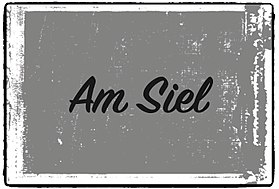At the sewer
| Movie | |
|---|---|
| Original title | At the sewer |
| Country of production | FRG |
| original language | German |
| Publishing year | 1962 |
| length | 13 minutes |
| Rod | |
| Director | Peter Nestler |
| script |
Peter Nestler , Marianne Beutler , Kurt Ulrich |
| camera |
Peter Nestler , Kurt Ulrich |
| occupation | |
| |
Am Siel (English title: At Sluice) is a documentary in black and white from Germany by director Peter Nestler from 1962 . The film premiered on February 12, 1963. The film documents life in a village at the end of a drainage canal in North Friesland.
content
As a Siel is called a drainage channel in a dike area. In his first film, Peter Nestler tells the story about a North Frisian village. The off-screen text begins as follows: “I am an old sluice with a village at the end. I don't know if the village liked being filmed, because someone who, like me, lies dead in the silt doesn't have much in mind with sharp eyes. My fairway is kept clear between wooden posts and entwined willow crops. A small river feeds them. My story is ground up by water and mud, from it the land won right and left is built, and the waves of the fishing boats have ebbed in this land. "
Almost without interruption, the old Siel continues to tell, while the camera carefully pulls along it and visits the ships at the end of the fairway, as well as the old inn with its people, the post office, the muddy streets and the war memorial.
During his contemplations, the sewer assumes almost human characteristics. In contrast to the hustle and bustle of the people in the village, the old sluice lies exhausted and almost timeless between the village and the sea. It is melancholy about life in his village, where people go about their work, meet in the inn, raise children and send them to school, but also go to wars in order not to return.
The perception of the village lies beyond a sober journalistic description, disturbed by the impossibility of the speaker and becomes a poetic piece of work through the unusual assembly technique of image and sound.
reception
In an interview with Peter Nestler reports that the film was the chance for him to mirror Germany in a village. Kurt Ulrich and he were particularly influenced in the 1960s by the assembly technology in Sergei Eisenstein's film Battleship Potemkin (1925). One of the advantages of their financial hardship and shortage of film material at the time was that they had to be very careful with the meters of film that were still available. That would have had the effect of drawing with a piece of chalk instead of painting in oil.
The film is an integral part of retrospectives, such as those shown worldwide on the occasion of Peter Nestler's 80th birthday.
Am Siel is currently available on a DVD with the complete works of Peter Nestler, the original 16 mm film was transferred to DCP ( Digital Cinema Package ).
Web links
- On the Dredge in the Internet Movie Database (English)
- On the Siel at filmportal.de
Individual evidence
- ↑ A conversation between Martin and Martin Grennberger Nestler. Magasinet Walden, accessed July 28, 2017 .
- ↑ Kay Hoffmann: Peter Nestler: Poetischer Provokateur. Films 1969 - 2009. In: 5 DVDs in a slipcase with booklet. absolut medien, accessed on July 28, 2017 (German, Spanish, Swedish).
